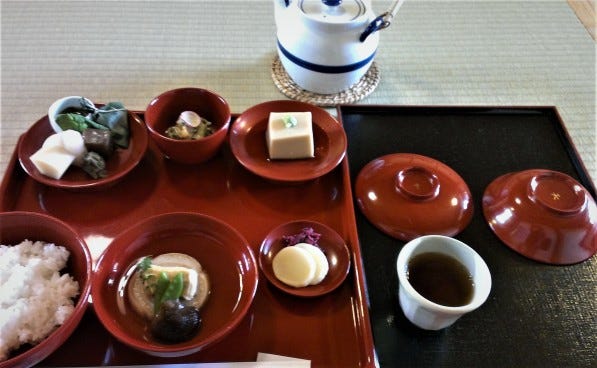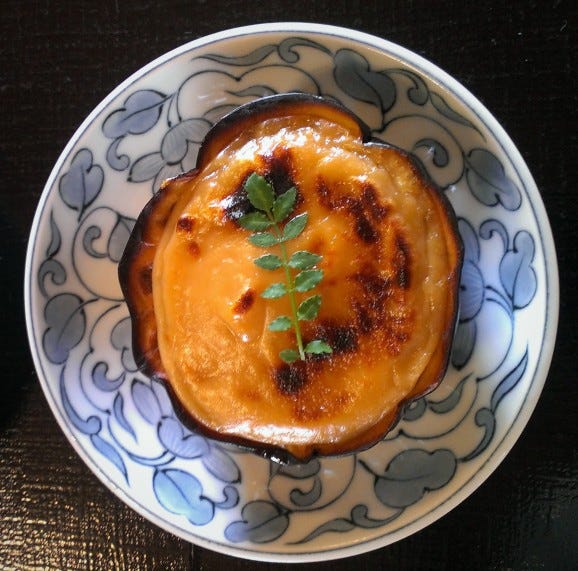Shojin Ryori: Japan's Ancient Vegetarian Tradition
A Buddhist vegetarian cuisine that has been around for over 800 years
Japan offers a blend of excitement, richness, and diversity to its visitors, including pristine nature, a fascinating culture, and a wide array of culinary experiences. While navigating food options as a vegetarian can be challenging in Japan, numerous apps now help travelers find excellent vegan and vegetarian restaurants. Interestingly, despite the abundance of plant-based options available today, many Japanese people are unfamiliar with vegetarian foods, even though the country had a primarily vegetarian diet just a couple of centuries ago.
Until the 18th century, plant-based agriculture was preferred over livestock farming. The influence of Buddhism and Shintoism contributed to a predominantly vegetarian diet throughout the country. Emperors frequently issued meat bans, allowing vegetarian diets to thrive for an extended period. It wasn't until the arrival of the Dutch, followed by the Americans after World War II, that meat consumption began to rise significantly—an increase that continues today. However, one ancient vegetarian cuisine has endured for over eight hundred years.
Japan’s Buddhist Vegetarian Cuisine
With the spread of Buddhism in Japan, there emerged a growing dissatisfaction among various sects, such as Tendai Buddhism, by the 13th century. Zen Buddhism began to take shape and gain popularity. This new form of Buddhism emphasized integrating daily life with the lifestyle of a monk. During this period, Dogen Zenji, a Zen master, penned guidelines for creating hearty vegetarian food. He posed an essential question: Why should preparing and eating food not be regarded as a form of meditation? This innovative approach to dining became known as Shojin Ryori.
To understand the significance of this concept, let's break down the term in Japanese. Shojin Ryori is written in Japanese as ‘精進料理’- Sho (精) – refined; shin (進) – advanced; ryori (料理) – cuisine. When combined, Shojin Ryori (精進料理) can be said to mean cuisine that advances enlightenment. When making shojin ryori, it is important to keep an attitude that inculcates three qualities: daishin (broad and open mind), kishin (joyful working attitude), roushin (always considering the other person’s feelings).
Ingredients and methods used to prepare Shojin Ryori
Those who prepare the food must pay close attention to colors, flavors, and methods, all in sets of five: flavors (salty, sour, bitter, spicy, sweet), colors (green, yellow, red, black, white), and cooking techniques (raw, boiled, baked, fried, steamed). It is also crucial to minimize waste; for example, vegetable scraps can be used as pickles or stock, while some can be fried to create tempura.
In addition to excluding meat and fish, shojin ryori avoids using strong-flavored raw ingredients like garlic and onion. This practice helps prevent monks from developing cravings for intensely flavored foods or from having their meditation interrupted.
Typically, the base of Japanese cuisine is a broth called dashi, made from dried kelp or fish flakes such as bonito. In shojin ryori, these ingredients are substituted with vegetarian options, resulting in a dashi made from dried kelp, mushrooms, vegetables, grains, or beans. Flavorings such as sesame oil, soy sauce, mirin (sweet rice wine), and miso (fermented bean paste) are used, but in subtle proportions.
Japan's distinct four seasons—summer, autumn, winter, and spring—provide opportunities to use fresh, seasonal ingredients. It is common to find fresh vegetables like cucumbers in the summer, sweet potatoes in the autumn, hearty root vegetables in the winter, and tender shoots or flower-based foods in the spring. Tofu, a protein-rich ingredient, is also utilized year-round.
Signature Shojin Ryori Dishes
While dishes vary by season and region, a typical shojin ryori meal will usually consist of soup, rice, side dishes, and pickles. A common starter is goma-dofu, which features tofu topped with sesame paste and wasabi (horseradish). Though it may appear simple, preparing this dish in the traditional manner requires considerable skill, particularly in grinding the sesame to the necessary fineness—a testament to the discipline demanded by shojin ryori. Another popular dish is nasu dengaku, grilled eggplant with glazed miso. Many people who are not fond of eggplant find their tastes changed after trying this delicious dish.
Rules of Shojin Ryori
There are several guidelines to observe when dining on shojin ryori. Most restaurants provide staff or signage to explain the basics, such as placing the lid back on your cup and moving it to the far right of your tray when you finish a dish, signaling to the staff to bring in the next course.
Experiencing Shojin Ryori
With its history and tradition associated with Zen Buddhism, Kyoto offers several places to enjoy shojin ryori. Tenryu-ji Temple, Daitoku-ji Ikkyu, Yoshuji in Kurama all have great shojin ryori menus. Other places to enjoy this cuisine include special restaurants in cities like Tokyo (e.g. Itosho).
The menus normally start at mid-level so shojin ryori is great to celebrate a special occasion.
At Tenryu Ji temple in Arashiyama in Kyoto, Shigetsu restaurant offers a large room facing a quiet garden where you can enjoy the varying texture and subtleties of shojin ryori. In this restaurant, guests are often seated together in a big hall. It can be very enjoyable to see how different people react to the many kinds of dishes that are offered. Much care is given to the order in which the dishes are brought, their arrangement and their preparation. It is only natural to slow down and think about the ingredients that went into each of the many dishes on the tray. Perhaps that was the intention of Dogen Zenji when he conceptualized shojin ryori hundreds of years ago.
Selected Sources
https://www.asahi.com/articles/DA3S16061476.html
Note
Some places will require reservations to be made for more than two guests, so it is worth contacting the restaurant in advance of your visit. The food will be 100% vegetarian, but some restaurants have recently started to use eggs or milk. If you are vegan or have any dietary restrictions or allergies, consult the staff prior to your meal.






I explain life and death and because I killed, I learned the importance of life. To be clear, I kept snakes, so I had to kill mice and rats to protect the snakes and feed them. This is why I am a Vegetarian by choice. These are some of my leassons learned in this podcast:
https://www.brighteon.com/0a84ab9f-912f-43c4-b24e-69ef02c7a25a